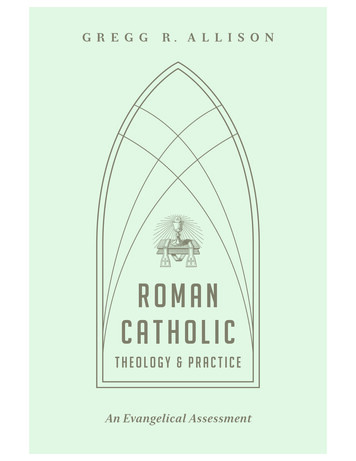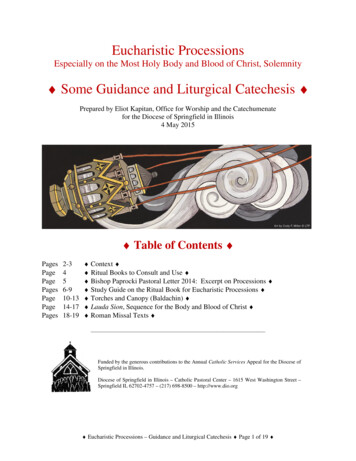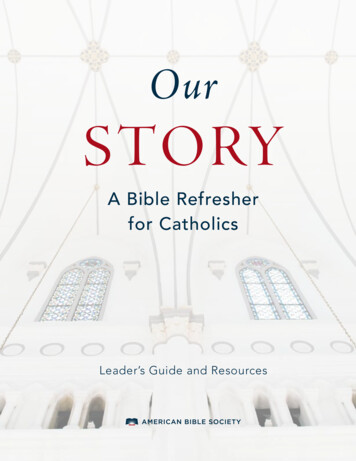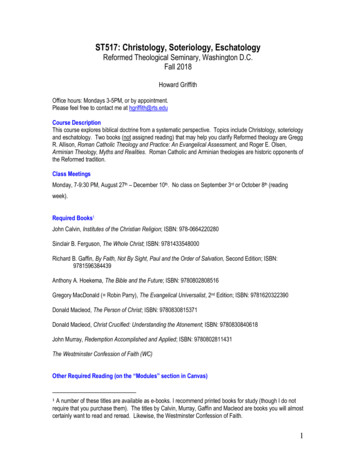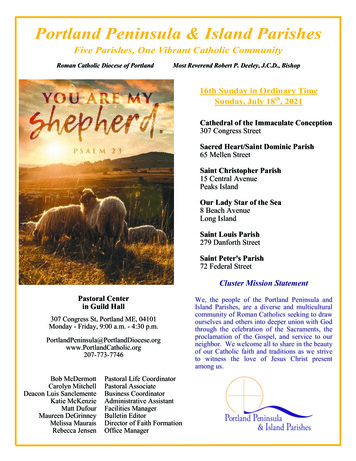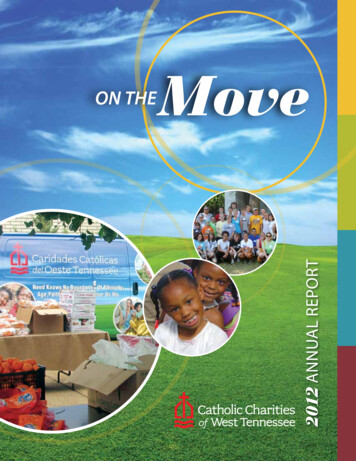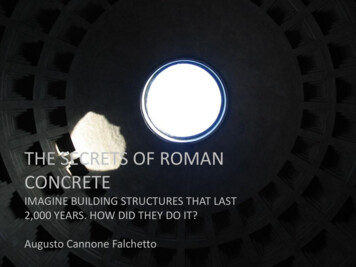
Transcription
ENGLISH CHANTResources for Singingthe Propers and Ordinary of the Roman RiteMass in EnglishPresentation bySteven W. Medicis, Director of Music, Saint James Church, Syracuse, New York
The Role of Chantin the Roman Rite LiturgyAccording to the Constitution on the Sacred Liturgy (Sacrosanctum Concilium),one of the constitutions of the Second Vatican Council solemnly promulgatedby His Holiness Pope Paul VI on December 4, 1963, 116. The Church acknowledges Gregorian chant as specially suited to theRoman liturgy: therefore, other things being equal, it should be givenpride of place in liturgical services. But other kinds of sacred music,especially polyphony, are by no means excluded from liturgicalcelebrations, so long as they accord with the spirit of the liturgical action. 117. The typical edition of the books of Gregorian chant is to becompleted; and a more critical edition is to be prepared of those booksalready published since the restoration by St. Pius X. It is desirable alsothat an edition be prepared containing simpler melodies, for use in smallchurches.
The Roman Gradual The “typical edition” specified in Article 117 is theRoman Gradual (Graduale Romanum), available inhardcopy form from several Catholic publishers ofsacred music including CanticaNOVA Publications, GIAPublications, and OCP. The Roman Gradual is the primary official book ofliturgical music for the Roman Rite. First published in 1908 at the request of Pope SaintPius X by the Benedictine monks of Abbaye Saint-Pierrede Solesmes in France and revised in 1974 followingthe issuance of the Roman Missal (Missale Romanum)of 1970.
The Simple Gradual The “edition containing simpler melodies, for use in smallchurches” specified in Article 117 is the Simple Gradual(Graduale Simplex), available in paperback form fromseveral Catholic publishers of sacred music includingCanticaNOVA Publications, GIA Publications, OCP. Like the Roman Gradual, the Simple Gradual is an officialbook of liturgical music for the Roman Rite. First published in 1967 at the request of Pope Paul VI by theBenedictine monks of Abbaye Saint-Pierre de Solesmes inFrance and revised in 1975 following the issuance of theRoman Missal (Missale Romanum) of 1970.
The Roman and Simple Graduals Both Graduals contain rubrics and music for the Proper ofthe Seasons, Common Masses, the Proper of the Saints,and Ritual and Votive Masses as well as appendices ofhymns, litanies, and other supplemental chants. The proper music for each listed Mass usually includes anEntrance antiphon and Psalm (Introit), Gradual Psalm orCanticle, Alleluia verse (Tract during Lent), Offertoryantiphon, and Communion antiphon and Psalm. Both include a Kyriale of chant settings of the ordinarymusic of the Mass (Kyrie, Gloria, Sanctus, and Agnus Dei),chant settings of the Nicene Creed, and music for thesprinkling of blessed water (Asperges Me and Vidi Aquam). Both Graduals are published entirely in Latin.
The Roman and Simple Graduals Because the Graduals are the official musicalresources of the Roman Rite, parish directors ofmusic should own a copy of each and be aware ofthe Church’s intention in terms of Scripturereference for the Entrance, Offertory, andCommunion songs of a particular Mass for whichthey plan music. Useful English chant resources tend to be basedon the music and texts of the Roman Gradual andSimple Gradual.
The Gregorian Missal The Gregorian Missal contains side-by-side Latin and English texts for thecomplete celebration of Mass, with Gregorian chant propers from theRoman Gradual for all Sundays and solemnities and for those feasts whichtake precedence over a Sunday. Scriptural references to readings of theLiturgy of the Word have been given.This missal was published in 1990 by the Benedictine monks of AbbayeSaint-Pierre de Solesmes in France.The Gregorian Missal is available free of charge online from MusicaSacra,the website of the Church Music Association of America (CMAA), al-online/. It isavailable in hardcopy form from several Catholic publishers of sacredmusic including CanticaNOVA Publications, GIA Publications, and OCP.All chants including the complete Kyriale are presented in Latin as in theRoman Gradual. While not a resource for English chant music, theGregorian Missal is easier to use as a music-planning resource than theRoman Gradual because it contains English text translations beneath theLatin music and text.
The Role of the English languagein the Roman Rite LiturgyAccording to the Constitution on the Sacred Liturgy (Sacrosanctum Concilium), one of the constitutionsof the Second Vatican Council solemnly promulgated by His Holiness Pope Paul VI on December 4, 1963, 36.1. Particular law remaining in force, the use of the Latin language is to be preserved in the Latinrites. 36.2. But since the use of the mother tongue, whether in the Mass, the administration of thesacraments, or other parts of the liturgy, frequently may be of great advantage to the people, thelimits of its employment may be extended. This will apply in the first place to the readings anddirectives, and to some of the prayers and chants, according to the regulations on this matter to belaid down separately in subsequent chapters. 36.3. These norms being observed, it is for the competent territorial ecclesiastical authority , todecide whether, and to what extent, the vernacular language is to be used; their decrees are to beapproved, that is, confirmed, by the Apostolic See. And, whenever it seems to be called for, thisauthority is to consult with bishops of neighboring regions which have the same language. 36.4. Translations from the Latin text into the mother tongue intended for use in the liturgy must beapproved by the competent territorial ecclesiastical authority mentioned above.
The Role of the English languagein the Roman Rite LiturgyAccording to the Constitution on the Sacred Liturgy (SacrosanctumConcilium), one of the constitutions of the Second Vatican Councilsolemnly promulgated by His Holiness Pope Paul VI on December 4,1963, 54. In Masses which are celebrated with the people, a suitableplace may be allotted to their mother tongue. This is to apply in thefirst place to the readings and “the common prayer,” but also, aslocal conditions may warrant, to those parts which pertain to thepeople, according to the norm laid down in Art[icle] 36 of thisConstitution.Nevertheless steps should be taken so that the faithful may also beable to say or to sing together in Latin those parts of the Ordinaryof the Mass which pertain to them
The Ordinary Chants in English:ICEL The International Commission on English in the Liturgy(ICEL), while working on an English translation of the thirdtypical edition of the Roman Missal (2002), assembled asmall group of expert musicians to prepare musical settingsof the English texts of the ordinary chants of the Mass(Kyrie, Gloria, Sanctus, Agnus Dei, et alia). The Commission approved settings for those parts of theOrder of Mass that received recognitio from the Holy See inJune 2008, and made these settings available online . The English chant settings are largely based on their Latincounterparts in the Roman Gradual and Simple Gradual.
The Ordinary Chants in English:ICEL In keeping with the mark of universality of the CatholicChurch, it is expected that all English-speaking Catholicclergy and congregations will be able to sing theCatholic Mass using the ICEL-approved English chantsettings. To further promote the use of these chants in theUnited States of America, the United States Conferenceof Catholic Bishops (USCCB) has mandated that acommon Order of Mass including the ICEL-approvedEnglish chant settings be published in all Catholicmissals, hymnals, and other liturgical guides.
The Ordinary Chants in English:CMAA The Church Music Association of America (CMAA)provides full downloads to the ICEL-approved Englishchant settings and video tutorials on its website athttp://musicasacra.com/music/rm2011/. Sound and musical-score files of unofficial CMAAedited English-language adaptations of complete Masssettings, settings of the Nicene Creed, and individualordinary chants (Kyrie, Gloria, Sanctus, and Agnus Dei)from the Roman Gradual and Simple Gradual areavailable at /.
The Proper Chants in English: TheChurch Music Association of America In addition to the previously-cited resources, the Church MusicAssociation of America (CMAA) website hosts or links to many otherfree English chant resources online athttp://musicasacra.com/music/. Most of the chant resources are complete texts for free download. While some were published in the 1960s or earlier, several arecurrent and relevant to the present Roman Missal, including theSimple English Propers, Lalemant Propers, American Gradual,Anglican Use Gradual, Laudate Dominum Communion Antiphons,and Communio with English Verses. Even the older texts can be of use as most of the chants appointedfor use with the Roman Missal of 1962 appear in the presentRoman Gradual.
The Proper Chants in English:The Simple English Propers Adam Bartlett’s project and book provides beautiful, accessible, and complete Entrance, Offertory,and Communion propers in English with psalms in modal chant. The project was sponsored and in2011 published by the Church Music Association of America.The Gregorian Missal is the composer’s point of reference for the development of these chants.The Simple English Propers are available for download free of charge athttp://media.musicasacra.com/books/simple english propers.pdf.The modes from the Gregorian original are wholly preserved to capture the sound and feel of theRoman Gradual proper chants.Twenty-three melodic formulas are employed including eight unique melodic models, one in eachGregorian mode, designated for three proper genres: Introit, Offertory, and Communion (no ModeVII Offertory formula exists as no Mode VII Offertory is found in the Gregorian Missal).Music is published with square-note neume notation.Organ accompaniment is available.Hard-copy versions of all editions are available for purchase.Antiphon text translations in English are from the Gregorian Missal. Psalm verses are taken fromthe Revised Grail Psalms.This resource is intended for use in the Ordinary Form of the Roman Rite.The proper chants of the Mass are available for all Sundays, Feasts and Solemnities of the Lord, andSolemnities of Saints, as well as for the Funeral and Nuptial Ritual Masses.
The Proper Chants in English:The Lalemant Propers This collection edited by Jeffrey M. Ostrowski of Corpus Christi Watershed contains very simplesettings in English of the Mass propers.The Lalemant Propers are available for download free of charge /.Gregorian Psalm tones are designated for each proper genre: Introit, Gradual, Alleluia, Tract,Offertory, and Communion.Music is published with square-note neume notation.No organ accompaniment is available.Hard-copy versions is available for purchase.Antiphon text translations in English are from the Gregorian Missal. Psalm verses are taken fromthe Revised Grail Psalms.This resource is intended for use in the Ordinary Form of the Roman Rite.The proper chants of the Mass are available for all Sundays, Feasts and Solemnities of the Lord,Solemnities of Saints, and the Commemoration of the Faithful Departed (All Souls’ Day).Many bonus features are included, such as proper hymns, the Good Friday Reproaches, and fortyfive complete Psalms pointed musically.
The Proper Chants in English:The American Gradual Bruce E. Ford’s adaptations of the chants of the Roman Gradual were firstpublished in 2001 and revised in a second edition in 2008.The American Gradual is available for download al1.pdf.Music is published with modern notation.No organ accompaniment is available.Texts are drawn from the 1979 American Book of Common Prayer and theRevised Standard Version English translation of the Bible.This resource is intended for use in liturgies of the Roman Rite, Anglicanpersonal ordinariates in communion with the Holy See, and the Episcopalchurch.The proper chants of the Mass are available for most Sundays and someSolemnities of the Lord.The American Gradual is a worthy effort at an English language adaptationof the Roman Gradual; however, most directors of music may find thechants too complex to teach to a volunteer choir on a weekly basis.
The Proper Chants in English:The Anglican Use Gradual C. David Burt’s adaptations of the chants of the Roman Gradual were firstpublished in 2004 by Patridge Hill Press in Mansfield, Massachusetts. A secondedition was published in 2006.The Anglican Use Gradual is available for download .pdf.Music is published with square-note neume notation.No organ accompaniment is available.Texts are drawn from the 1928 United States edition of the Book of CommonPrayer. As such, the language may be considered worthy by some and antiquatedby others.This resource is intended for use in Anglican personal ordinariates in communionwith the Holy See, but suitable for use in the Roman Rite.The proper chants of the Mass are available for all Sundays, Feasts and Solemnitiesof the Lord, and Solemnities of Saints.The Anglican Use Gradual closely follows the structure of the Roman Gradual, butin most cases not the chants themselves. The chants are simpler than those in theAmerican Gradual, but the language is more archaic.
The Proper Chants in English:Laudate Dominum Communion Antiphons Andrew R. Motyka composed simple, modal melodies for English paraphrases ofthe Communion antiphons of the Roman Gradual to be sung responsorially duringthe Communion procession, when it is inconvenient for communicants to singhymns that require them to carry a hymnal or missal.The Laudate Dominum Communion Antiphons are available for download athttp://www.communionantiphons.org/.Music is published with modern notation.Organ accompaniment is available.Each antiphons is set in the same Gregorian mode as the corresponding antiphonin the Roman Gradual. These are accompanied by English Revised Grail Psalmverses as referenced in the Roman Gradual set to the Saint Meinrad Psalm tones.This resource is intended for use in the Ordinary Form of the Roman Rite.The proper Communion chants of the Mass are available for all Sundays, all Feastsand Solemnities of the Lord, and most Solemnities of Saints, as well as for theFuneral and Nuptial Ritual Masses.
The Proper Chants in English:The Communio with English Verses Richard Rice’s edition of Communio with Latin Psalm verses was published in 2007by the Church Music Association of America in Richmond, Virginia. The editionwith English-language Psalm verses was printed in 2009.The Communio with English Verses is available for download athttp://media.musicasacra.com/books/communio english.pdf.Music is published with square-note neume notation.No organ accompaniment is available.Communion antiphons are given using the original Latin text and Gregorian musicfrom the Roman Gradual with English-language text-only translations. These areaccompanied by English Psalm verses as referenced in the Roman Gradual set tothe Psalm tones of the Divine Office.English texts of the Psalm verses are drawn from the Douay-Rheims translation ofthe Latin Vulgate.This resource is intended for use in the Ordinary Form of the Roman Rite.The proper Communion chants of the Mass are available for all Sundays, Feastsand Solemnities of the Lord, and Solemnities of Saints.Chants are presented alphabetically by the first few words of the Latin text of theantiphon, although a liturgical index is provided.
Other English Chant Resources:Saint Meinrad Chants Father Columba Kelly, O.S.B., and Saint Meinrad Archabbey in Saint Meinrad, Indiana, provideseveral English-language chant resources at l-music/downloads/ (select the “Fr. Columba” category).Father Kelly has adapted the chants of the Roman Gradual to the text of the English translation ofthe Roman Missal and its Antiphonary to provide propers (Introit, Responsorial Psalm, Verse beforethe Gospel, and Communion) and Psalm verses for the Masses of Advent, Christmastide, Lent,Eastertide, Ordinary Time, Solemnities during Ordinary Time, the Nuptial Mass, and the FuneralMass.Although the third typical edition of the Roman Missal makes provision for singing the antiphons ofthe Roman Missal, these antiphon texts often differ substantially from those found in the RomanGradual–especially during Ordinary Time—and according to the 1975 American adaptation of theGeneral Instruction of the Roman Missal of 1970 were originally intended to be spoken by thepriest and assembly during Masses without a choir (“Masses without singing”).Father Kelly also makes available the Saint Meinrad Kyriale of ordinary chants in English. However,some of the English chants in this Kyriale conflict with their official versions as found in the RomanMissal.Music is published with square-note neume notation.No organ accompaniment is available.Psalm tones, an English-language setting of the Exsultet, and Verses before the Gospel for theliturgical year are provided as well.
Other English Chant Resources The Proper of the Mass for Sundays and Solemnities: Father SamuelWeber, O.S.B., Director of the Benedict XVI Institute for SacredMusic and Divine Worship in the Archdiocese of San Francisco,California, Office of Sacred Worship, adapted the chants of theRoman Gradual to the texts of the Roman Missal and RomanGradual, Lectionary for Mass, and Douay-Rheims translation of theLatin Vulgate to provide settings of the Introit, Responsorial Psalm,Verse before the Gospel, Offertory, and Communion in severaldegrees of difficulty. is available in hardcopy form from IgnatiusPress at r-ofthe-mass-for-sundays-and-solemnities.aspx. By Flowing Waters: Chant for the Liturgy: Paul F. Ford’s Englishlanguage adaptation of the Simple Gradual was published in 1999by the Order of Saint Benedict in Collegeville, Minnesota. It isavailable in hardcopy form from Liturgical Press athttp://www.litpress.org/Detail.aspx?ISBN 0814625959.
Other English Chant Resources The Chant Café, a project of the Church Music Associationof America, is a liturgy blog for Catholic musicians. Corpus Christi Watershed offers thousands of ResponsorialPsalm scores, MP3 sound files, and practice videos,including the Saint Noël Chabanel Responsorial Psalms, allof which are available for free download. Much of themusic is English-language chant. CanticaNOVA Publications bills itself as a provider of“traditional music for the contemporary church”. Its onlinecatalog contains many examples of English-language chantsettings of the proper and ordinary of the Roman RiteMass.
Other English Chant Resources The Chant Café, a project of the Church Music Associationof America, is a liturgy blog for Catholic musicians. Corpus Christi Watershed offers thousands of ResponsorialPsalm scores, MP3 sound files, and practice videos,including the Saint Noël Chabanel Responsorial Psalms, allof which are available for free download. Much of themusic is English-language chant. CanticaNOVA Publications bills itself as a provider of“traditional music for the contemporary church”. Its onlinecatalog contains many examples of English-language chantsettings of the proper and ordinary of the Roman RiteMass.
Other English Chant Resources These are but a small sample of the Englishlanguage chant resources that exist online andelsewhere. Directors of music should take time to explore thewealth of resources available to them by taking amore active approach to liturgical music-planninginstead of limiting themselves to music andplanning resources supplied by one particularpublisher of Catholic liturgical and sacred music.
The Role of the Faithful and the Choirin the Roman Rite LiturgyAccording to the Constitution on the Sacred Liturgy (Sacrosanctum Concilium), one ofthe constitutions of the Second Vatican Council solemnly promulgated by His HolinessPope Paul VI on December 4, 1963, 14. Mother Church earnestly desires that all the faithful should be led to that fullyconscious, and active participation in liturgical celebrations which is demanded bythe very nature of the liturgy. Such participation by the Christian people as “achosen race, a royal priesthood, a holy nation, a redeemed people (1 Pet. 2:9; cf.2:4-5), is their right and duty by reason of their baptism.In the restoration and promotion of the sacred liturgy, this full and activeparticipation by all the people is the aim to be considered before all else; for it isthe primary and indispensable source from which the faithful are to derive thetrue Christian spirit; and therefore pastors of souls must zealously strive to achieveit, by means of the necessary instruction, in all their pastoral work.Yet it would be futile to entertain any hopes of realizing this unless the pastorsthemselves, in the first place, become thoroughly imbued with the spirit andpower of the liturgy, and undertake to give instruction about it. A prime need,therefore, is that attention be directed, first of all, to the liturgical instruction ofthe clergy
The Role of the Faithful and the Choirin the Roman Rite LiturgyAccording to the Constitution on the Sacred Liturgy(Sacrosanctum Concilium), one of the constitutions of theSecond Vatican Council solemnly promulgated by His HolinessPope Paul VI on December 4, 1963, 114. The treasure of sacred music is to be preserved andfostered with great care. Choirs must be diligentlypromoted, especially in cathedral churches; but bishopsand other pastors of souls must be at pains to ensure that,whenever the sacred action is to be celebrated with song,the whole body of the faithful may be able to contributethat active participation which is rightly theirs
The Role of the Faithful and the Choirin the Roman Rite Liturgy Article 14 has been widely misunderstood tomean that the congregation must sing everysung part of the Mass.
The Role of the Faithful and the Choirin the Roman Rite Liturgy Article 114 clearly distinguishes between the role ofthe choir and the role of the congregation. This means that at times the congregation and choirmay sing together, at times the choir and congregationsing in dialogue with one another, and at times thechoir sings alone. Unless an easy to remember and repeated properantiphon is used responsorially at Entrance, Offertory,or Communion, it is allowable for a choir to sing aloneas needed during these processions as long as thecongregation can participate exteriorly in song at othertimes during the Mass.
The Role of the Faithful and the Choirin the Roman Rite Liturgy The “fully conscious and active participation”clause of Article 14 has also been commonlymisinterpreted by many who understandparticipation to be visible and external innature. The Church, however, recognizes the need forboth internal and external participation.
The Role of the Faithful and the Choirin the Roman Rite LiturgyAccording to the Musicam Sacram, Instruction on Music in the Liturgy, the lastauthoritative document regarding sacred music promulgated by the SacredCongregation of Rites on March 5, 1967, 15. The faithful fulfill their liturgical role by making that full, conscious and activeparticipation which is demanded by the nature of the Liturgy itself and which is, byreason of baptism, the right and duty of the Christian people.This participation(a) Should be above all internal, in the sense that by it the faithful join their mindto what they pronounce or hear, and cooperate with heavenly grace,(b) Must be, on the other hand, external also, that is, such as to show the internalparticipation by gestures and bodily attitudes, by the acclamations, responses andsinging.The faithful should also be taught to unite themselves interiorly to what theministers or choir sing, so that by listening to them they may raise their minds toGod.
The Role of the Faithful and the Choirin the Roman Rite LiturgyAccording to the Musicam Sacram, Instruction on Music in the Liturgy, the last authoritative documentregarding sacred music promulgated by the Sacred Congregation of Rites on March 5, 1967, 16. One cannot find anything more religious and more joyful in sacred celebrations than a wholecongregation expressing its faith and devotion in song. Therefore the active participation of thewhole people, which is shown in singing, is to be carefully promoted as follows:(a) It should first of all include acclamations, responses to the greetings of the priest and ministersand to the prayers of litany form, and also antiphons and psalms, refrains or repeated responses,hymns and canticles.(b) Through suitable instruction and practices, the people should be gradually led to a fuller—indeed, to a complete—participation in those parts of the singing which pertain to them.(c) Some of the people's song, however, especially if the faithful have not yet been sufficientlyinstructed, or if musical settings for several voices are used, can be handed over to the choir alone,provided that the people are not excluded from those parts that concern them. But the usage ofentrusting to the choir alone the entire singing of the whole Proper and of the whole Ordinary, tothe complete exclusion of the people's participation in the singing, is to be deprecated.
Singing the Propers The Church herself encourages the singing ofthe propers.
Singing the PropersAccording to the English translation of the General Instruction of the Roman Missal(third typical edition) of 2002, 47. When the people are gathered, and as the Priest enters with the Deacon andministers, the Entrance Chant begins. Its purpose is to open the celebration, fosterthe unity of those who have been gathered, introduce their thoughts to themystery of the liturgical time or festivity, and accompany the procession of thePriest and ministers. 48. This chant is sung alternately by the choir and the people or similarly by acantor and the people, or entirely by the people, or by the choir alone. In theDioceses of the United States of America there are four options for the EntranceChant: (1) the antiphon from the Missal or the antiphon with its Psalm from theGraduale Romanum as set to music there or in another setting; (2) the antiphonand Psalm of the Graduale Simplex for the liturgical time; (3) a chant from anothercollection of Psalms and antiphons, approved by the Conference of Bishops or theDiocesan Bishop, including Psalms arranged in responsorial or metrical forms; (4)another liturgical chant that is suited to the sacred action, the day, or the time ofyear, similarly approved by the Conference of Bishops or the Diocesan Bishop
Singing the PropersAccording to the English translation of the General Instruction of the Roman Missal(third typical edition) of 2002, 74. The procession bringing the gifts is accompanied by the Offertory chant ,which continues at least until the gifts have been placed on the altar. The normson the manner of singing are the same as for the Entrance chant (cf. above, no.48). Singing may always accompany the rite at the offertory, even when there isno procession with the gifts. 87. In the dioceses of the United States of America there are four options for theCommunion chant: (1) the antiphon from the Roman Missal or the Psalm from theRoman Gradual as set to music there or in another musical setting; (2) theseasonal antiphon and Psalm of the Simple Gradual; (3) a song from anothercollection of psalms and antiphons, approved by the United States Conference ofCatholic Bishops or the Diocesan Bishop, including psalms arranged in responsorialor metrical forms; (4) a suitable liturgical song. This is sung either by the choiralone or by the choir or cantor with the people.
Singing the Propers “It is proper to sing the propers.” Notice that at Entrance, Offertory, and Communion,the first option for song is always the proper antiphonand accompanying Psalm or canticle of the Mass. Most congregations exclusively use the fourth, lastoption—“a suitable liturgical song”—when singingduring these processions. This exclusive insistence onthe use of the last option runs contrary to the reasonthat the Church provided options in the first place. Itdoes not seem to be the intention of the Church in thecelebration of the Roman Rite. A more rich and variedcelebration of the Mass is envisioned.
Incorporating English Chant intoParish Masses with a Congregation There are many ways to incorporate English-language chantpropers and Psalms into the celebration of Mass withoutexcluding the people from singing as is their duty and right. Sing a joyful psalm instead of “Sing a New Song”. Mostcongregations are used to singing a Responsorial Psalm atMass. They could similarly repeat a simple antiphonbetween verses of a Psalm sung by a cantor or choir. This would be especially beneficial to encouragecongregational singing during the Communion procession,when it is cumbersome for people to carry music books andsing a hymn while walking and receiving Holy Communion.
Incorporating English Chant intoParish Masses with a Congregation For the congregation that has no experience with English chant, it isbest to begin by teaching a setting of the ordinary of the Mass, asthis can be repeated each week. The implementation of the English translation of the third typicaledition of the
Apr 30, 2016 · 117. The typical edition of the books of Gregorian chant is to be completed; and a more critical edition is to be prepared of those books already published since the restoration by St. Pius X. It is desirable also that an edition be prepare
